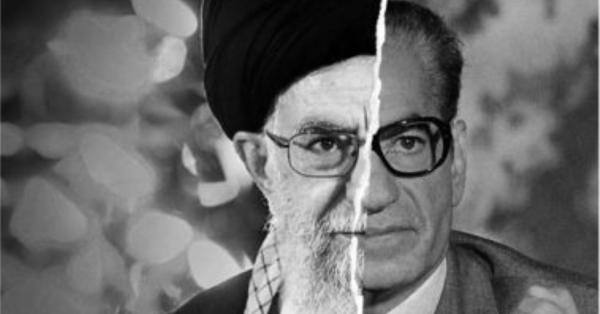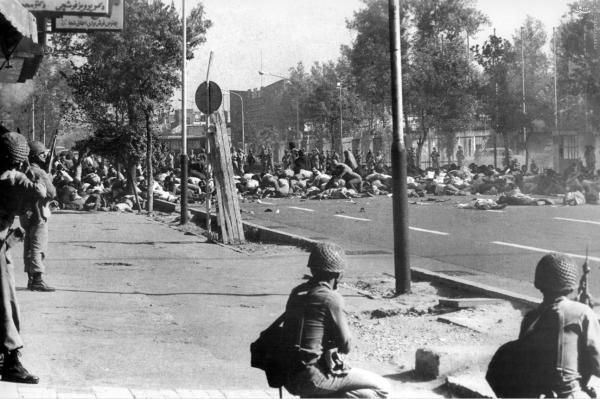“The Shah Is a Fascist Butcher! Down with the Shah!”
In the 1970s, this chant rang out, in marching cadence, wherever Iranian students were studying abroad. They were protesting the hated regime of Mohammad Reza Pahlavi—the Shah (an absolute monarch) who had ruled Iran with an iron, bloodstained, American-approved fist since 1953. Their cry fueled and foreshadowed the 1978-79 revolution that overthrew this U.S. puppet, a revolution hijacked by the reactionary fundamentalists who formed today’s deeply hated Islamic Republic of Iran.
For the last four months the cry “Woman, Life, Freedom”—and increasingly “Down with the Dictator”—has reverberated across Iran and around the world. This uprising, unprecedented in the 44-year rule of the Islamic Republic, is giving rise to sharp debate—both inside Iran and among the millions of Iranians living in other countries (the “diaspora”)—over what kind of government and society should replace Iran’s despised theocracy.

Combined portraits of oppressors: Ayatollah Khamenei, current Supreme Leader of the Islamic Republic of Iran (left); and Mohammad Reza Pahlavi, former Shah (king) of Iran (right).
One current argues that life was better, freer, and more prosperous under the Shah’s rule, especially in terms of women’s rights. Recently, some prominent voices in the diaspora have launched a campaign to name Reza Pahlavi, the Shah’s son who lives in the U.S., as the people’s representative to lead a transition from the current theocracy (rule by religious law and authorities) to a new government: a pro-U.S. secular bourgeois democracy, based on, and linked to, the global capitalist-imperialist system.1
So for those who may have forgotten, and for those who never knew, here is a brief account of the unspeakable nightmare that life under the Shah was for the vast majority of Iranians, a nightmare no one should prettify or wish to return to—in any form.
Amnesty International: “a history of torture which is beyond belief… No country in the world has a worse record in human rights than Iran”
- “I was told that if I didn’t confess, my wife and thirteen-year-old daughter would be raped in front of my eyes. All this time I was being beaten from head to toe.… [This] went on for 102 days.” —Imprisoned Iranian writer2
- One radical opponent of the regime was forced into an electric oven and burned so badly he was paralyzed. Even after he was executed, the secret police refused to return his body to his family.3
- Amnesty International reported that Iran had the “highest rate of death penalties in the world, no valid system of civilian courts and a history of torture which is beyond belief. No country in the world has a worse record in human rights than Iran.”4
Readers might assume we’re describing the crimes of the Islamic Republic of Iran.
We’re not. All these are examples of the depraved brutality carried out by the former Shah to maintain his oppressive rule. Much of this was carried out by SAVAK, the Shah’s dreaded secret police, which was founded in 1957 under the direction of the CIA (later assisted by Israel).

Horrifying torture by the Shah’s secret police, left; executions after the 1953 CIA coup installed the Shah, right.
Put on the Throne by the CIA to Serve U.S. Imperialism—Not the Iranian People
The Shah was put in power by the tanks and bayonets of a CIA-orchestrated coup d’etat. He wasn’t put there to serve the Iranian people. He was put there to serve U.S. imperialism, and he was their frontman and lackey in Iran until he was driven from power by the Iranian people.5
- During the Shah’s reign, Iran was a key cog in the U.S. imperialist empire—economically, politically, and militarily. Iran’s economy, including its oil industry, beat to the heart of global capitalism-imperialism, not the lives of Iranians.
- As millions of Iranians toiled in poverty, the Shah spent billions building a massive police state and turning Iran into a military outpost, together with Israel, for U.S. domination of the Middle East and to face off against the then-Soviet Union. Between 1972 and 1975 alone, Iran spent $35 billion of its $62 billion in oil revenues on the military, mainly on purchases from the U.S. and other Western powers.6
- When the millions of Iranians rose up during the 1978-79 revolution, the Shah’s forces repeatedly shot down protesters. On September 8, 1978 (“Black Friday”) alone, they massacred some 4,500 unarmed demonstrators in Tehran. Afterward then-President Jimmy Carter called the Shah to assure him of continued U.S. support.7

U.S. President Jimmy Carter with the Shah of Iran, 1977
Champion of Women’s Rights? Or Patriarchy and Male Property?
The Shah’s regime enacted measures in the 1960s and ’70s granting women the right to vote and hold political office, to initiate divorce proceedings in family courts (rather than before religious authorities), and limiting (but not eliminating) polygamy, among other things. These weren’t aimed at ending patriarchy; they were aimed at meeting the needs of imperialist-driven development and geopolitics, and often demanded by the U.S. A more skilled workforce was required to serve growing urban industry and services. These reforms were also aimed at undercutting Soviet inroads in the region by giving the appearance that the Shah’s regime was modern and progressive.
In reality:
- The law continued to construct women as male property. Under the Shah’s divorce law, it was deemed “misbehavior” if a wife failed “to surrender herself to her husband’s embrace”—i.e., have sex on demand. Husbands could demand that his wife quit any job that he thought was “repugnant to the interests of her or his family.”8
- “Despite the veneer of modernity, in 1977 only 35 percent of women in Tehran were literate and in 1979, on the eve of the Revolution, they made up just 30.8 percent of university entrants.”9
- Most women in rural areas or Iran’s sprawling shantytowns remained stuck in poverty and lack of health care or education. Women in rural areas were excluded entirely from receiving land under the “White Revolution.” In 1972, they were the majority of the rural workforce; they were very poorly paid and worked in terrible conditions. As late as 1975 rural illiteracy was 60 percent for men and 90 percent for women.10 Many women remained under the domination of the traditional relations of the family, village and/or mosque, often confined to the home and childcare, and forced to wear the hijab.
Improving the Lives of the Iranian People?
During his reign, U.S. officials and the media portrayed the Shah as an enlightened modernizer who was making life better for the Iranian people. A better description would be a brutal exploiter who teamed up with the U.S. and other world powers to plunder Iran and its people.
- The “agrarian reform” component of the Shah’s 1963 “White Revolution” (designed and directed by the U.S.) was hailed as a lifting of Iran’s peasants and rural workers out of backwardness and poverty. In reality, big landlords and better-off farmers were the main beneficiaries and only 20 percent of peasant families actually received land, often in parcels too small to be viable. Landless laborers—half the rural population—got nothing.
- These “reforms” resulted in nearly 600,000 families leaving the land and migrating to urban areas, often to sprawling urban shantytowns without water, sewage, or electricity.11
- Urban industry grew rapidly, but it was crazy‑quilt, lopsided growth fueled by extreme exploitation—a few high-tech islands in a sea of tradition and misery. There were modern bottling plants for Pepsi, Coke, and Canada Dry, while in slums and shantytowns people were still drinking from the open drains running down the sides of streets.12
- Dispossessed peasants seeking work in cities remained bitterly impoverished. One construction worker told of working on a new palace for the Shah’s mother, but making only $3 a day, barely enough to pay for cab fare and a lunch of bread and cheese. In the late 1970s, 60 percent of Iranians remained illiterate, life expectancy was 50 years, and 139 of every 1,000 children died in their first year.13
- Meanwhile the Shah flaunted his enormous wealth spending $2.5 billion on a 1971, three-day celebration of 2,500 years of the Persian empire, and installing a solid gold toilet worth a reported $2 million in one of his many palaces.14

September 8, 1978, hundreds of protesters were killed or wounded by the Shah’s U.S.-backed military in Jaleh Square in Tehran. They were among the thousands killed by the Shah in cities around Iran that day.
Suppressing and Impoverishing Iran’s Minority Nationalities
Four Iranians out of ten are members of a minority, non-Persian, nationality, such as Azeri, Kurdish, Arab, Baluch and others, each with their own language, culture, history and way of life. The Shah’s regime enforced Persian supremacy and chauvinism. Persian/Farsi was the official language, while minorities faced all kinds of discrimination, oppression and neglect:
- The 10-20 plus million minority peoples were denied any national or cultural rights and forbidden from using their languages in education, law or business, undermining their cultures.15 Kurds, Arabs, Azeris, and others were subjected to racist insults. Only Persian history was taught, not theirs.16
- Iran’s ethnic minorities live in Iran’s poorest provinces, deprived of development, infrastructure, and government services. When these oppressed peoples rose up in rebellion, they were subjected to military assaults and draconian punishment.
- Kurdistan, home to one of ten Iranians, has been subjected to repeated manipulations, betrayals and military assaults.17 Largely untouched by the reforms of the “White Revolution,” about 80 percent of its people still lived in villages in the 1960s, often with neither electricity nor running water. In 1979, one peasant said, “We have nothing here, no jobs and no schools, no electricity and no hospitals—no life and no future.”18
Neither Shahs nor Theocrats!
The facts and history show that the Shah did not liberate women, improve life for the vast majority of Iranians, or provide any degree of political freedom. Instead, he was a fascist butcher and a despotic enforcer of the interests of the oppressors of the Iranian people, first and foremost the U.S. Did some people benefit from his rule? Yes—there has never been a regime in history that wasn’t good for some section of people. But overall and overwhelmingly, the reign of the Shah was a nightmare for the vast majority in Iran.
Conclusion: Neither the Shah’s U.S.-backed monarchy nor the current Islamic theocracy offer any of the freedoms and liberation that the Iranian people are so courageously aspiring to. Nor is that possible so long as the system that is ruling over people is based on and tied to the whole international network of capitalism-imperialism—as the rule of both the Shah and the Ayatollahs has been.
What is required instead is spelled out by the Communist Party of Iran (Marxist-Leninist-Maoist), which bases itself on the new communism brought forward by Bob Avakian:
To finally put an end to the seemingly endless suffering of Iran’s people requires a real revolution, made by millions of people and led by a revolutionary vanguard with the aim of overthrowing the Islamic theocratic fascist regime and liberating Iran out of the murderous fabric of the capitalist-imperialist system. This requires a communist revolution and establishing a “New Socialist Republic.”19